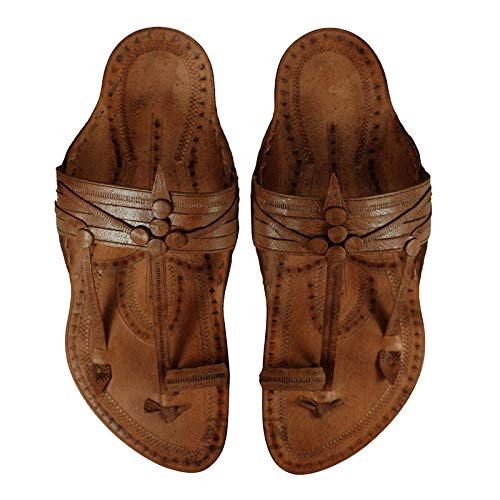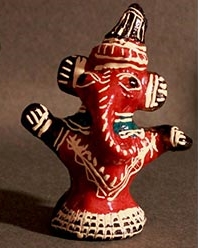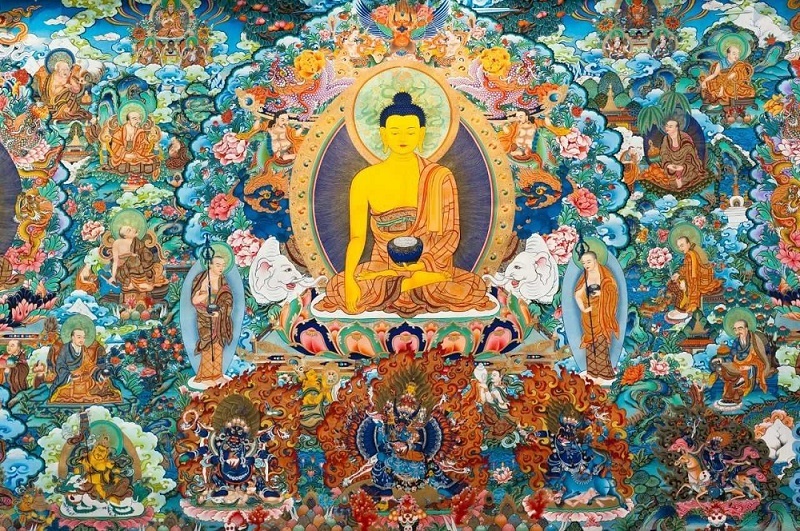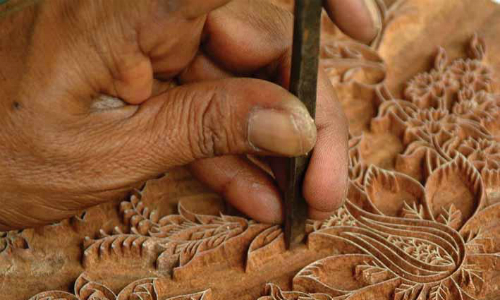Traditional Crafts
Maharashtra
Kolhapur

Kolhapuri Chappal - leather footwear
Kolhapuri chappals are handcrafted leather footwear originally made in Kolhapur by the chamar community for daily wear. No nails are used in the making and the chappals are made completely out of buffalo hide with fine goat leather used for the plaited designs. The chappals are available in natural tan, deep maroon, mustard yellow, and dark brown colour. They come in a variety of designs and are decorated with leather braids and zari cords.

Wooden toys, Sawantwadi
Wooden toys are made in Sawantwadi by turning or carving mango wood. Originally they were created by the chitari or chitrakars. After turning seasoned mango wood, lac mixed with colours is applied to the finished surface. Toys are also made by cutting different profiles, which are later assembled into the completed product. The cutout pieces are finished by sanding, painted, and assembled.

Silver ware, Hupari, Kolhapur
Silver artifacts like incense sticks and lamps, are used an integral part of Maharashtrian religious ceremonies. Untreated silver is first melted and set in molds of the required shape. These artifacts are embossed with intricate designs. Parts of the products are made separately and then soldered together. Finally the item is polished either matt or gloss with a brush using a soapnut powder solution. Hupari in Kolhapur district is well known for this craft.
Aurangabad, Ahmednagar

Terracotta and pottery
Clay objects for domestic and rituals are made in Aurangabad and Ahmednagar. One such special product are the clay bulls for children used during the festival of Pola - a festival when bulls are worshipped and decorated. The potters also make the tandoor, a traditional earthen stove, which is made with a flat base and then built up with coiled layers before being fired.

Copper and brass ware
Copper and brass utensils are made by hammering metal sheets and creating different forms. The lota is made by joining together a bowl-shaped base and the bell-shaped upper part. Saltwater is used during the welding process to provided a red tinge.

Metal embossing
This technique creates embossed motifs and designs in sheet metal like silver, gold, copper, brass, and aluminum. The sheet of metal is placed on liquefied tar after the heated tar solidifies and cools. The design is drawn on the sheet. An etching tool is used to create the outline on the surface of the sheet while a dulling tool presses down the portion that is not to be highlighted. The embossed portion is given shape by a chipping tool. Once the embossing is complete, the pitch is reheated to remove the embossed sheet which is cleaned in diluted sulphuric acid and washed with soapnut solution. The sheet is wiped, brushed, and polished.

Ambadi- sisal craft
Sisal (Agave Sisalana) is a cactus whose fibre was used to make rope. The fibre extracted from cactus leaves, is cleaned, dyed, braided, and stitched together to produce a range of products that are strong and water-resistant. The braids are coiled and stitched together or stitched from edge to edge.

The Warli painting
The Warli tribe from the Thane district, paint sacred pictographs on the walls of their huts during wedding rituals. Rice paste and straw are applied on the wall and used as the base. Motifs inspired from life, depicting nature, epics, legends, local incidents, and tales painted on the walls. The base is coloured and the drawings are in white, painted with a brush made of twigs. The human figures are a combination of lines and triangles drawn in various activities such as working, dancing, cultivating land.
Nagaland

Basket Weaving
The men in Nagaland weave the most intricate and beautiful baskets to carry agricultural produce. Though woven baskets are readily available in Nagaland, the intricate baskets made for carrying produce are difficult to find as men weave them in their spare time.

Handlooms Weaving
Women weave unique and intricate designs in cotton and wool on small looms. Traditionally fabric was woven into shawls or garments. Today varied items such as table runners mats, napkins and cushion covers are available.

Wood Carving
In Nagaland large pieces of wood, sometimes logs are roughly carved producing dynamic pieces of wood sculpture. Traditionally wood was used to carve figures, iconic symbols such as the Mithun horns, gateways and doors. These all had symbolic meanings. Today wood carving is commonly used for furniture wall plaques.

Spears
Spears are made out of metals combined with a wood shaft. They are made for hunting are beautifully decorated in traditional colours of red, black, off white.

Batik prints
Batik, the ancient wax-dyeing handloom art form, is native to Indonesia and was promoted in Bengal by Rabindranath Tagore. Batik print units were set up in Viswabharati University where local village folks, artistes were trained. The batik print of Bengal, particularly of Shantiniketan, Bolpur has been used in all kinds fabric; such as a Batik printed silk/cotton saree, handkerchiefs, blouse pieces, home furnishing or leather handcrafts. ‘Shantiniketani Batik’ is now a household name.
The fabric is waxed before being dyed in rich colours from vegetable dyes. Molten wax filled in a bowl is pressed on the fabric with a Tjanting or Kalamkari pen. Designs etched on wooden blocks, are mounted on a screen, and then pressed on the fabric. This technique is popularly known as screen printing. Batik designs are creative and inspired by nature and motifs. After the designs are waxed, the coloration process begins. Colours seep through cracks in the wax and create designs which are unique to batik. In the final stage, the fabric is carefully de-waxed using boiling water. Batik printing in Bengal is continually evolving and experimented with.
By Aditi Chakraborty

Beaten Silver Work
Beaten silver work in Bengal is used to create silver cutlery sets, bowls, silver containers, vermillion cases and many other item. Silver sheets are beaten with hammers, chisels and files are used to produce fine detailing and intricate curvature. The material used is silver and brass in a ratio of 16:7. After completion they are hand polished.
By Aditi Chakraborty

Beaten Silver, Darjeeling
Beaten silver objects of Darjeeling, Sikkim and Kalimpong are way different from their Kolkata counterparts. The artefacts here are made of wood. Then silver embossed sheets are fitted onto them to give a luxurious finishing. Also, these objects show a deep veneration for traditional Tibetan religious symbols, designs and motifs such as ‘Om Mani Padme Hum’, Tashi Takgye, the lotus and the wheel of life. Be it the very famous Nepalese ‘kukris’ (knives), bells, flutes, butter lamps or utensils for religious usage; it is religion which is the abiding theme in this beaten silver craft.
The craftsmen mostly reside in clusters in and around Kalimpong and also in Tibetan Refugee Centres. They beat the silver with skilful hands into thin fine sheets and then fine engraving is worked into the silver which include religious motifs. Tools like hammers, chisels and files are used in the process. The knowledge and craftsmanship re passed on from generation to generation by the craftsmen. Bronze is also used with the silver mix to make containers and tea kettles with beautiful long necks

Filigree Worked Gold Kan (full-ear ornament with short jhumka) Image Courtesy: facebook.com
Filigree work in jewellery in Bengal is a very old craft that has its counterpart in Odisha, famously known as ‘tarkashi’ work. In ‘Bowbazar,’ Kolkata, the goldsmiths are continuing this craft for generations who hail mostly from South 24-Parganas district.
Very fine wires of precious metals such as gold and silver are interwoven to create intricate motifs and designs in filigree. The designs are largely inspired by temple inscriptions and natural themes. Creepers and lattice work are common motifs. Gold and silver are first melted on medium heat and then poured into moulds to create rods. These rods, when inserted into manual wire drawing machines, are transformed into super fine wires. Designs are then drawn on paper and the hair-thin wires are placed upon the designs to create the basic outline. The craftsman first solders the super-thin metal strands to the outline of the design. The entire process is very delicate and the gold/silversmith takes great care so that the wires do not break in the process. The final piece of jewellery is again heated for better consolidation and polished before being sold.

Kansa Utensils from Bengali Kitchen - Image courtesy Goya Journal
Kansa and peetal (brass) utensils are traditionally used for cooking and serving in West Bengal. The metal, kansa, is a mix of copper and tin and everyday utensils made from this alloy are solid and extremely durable. Depending upon the manufacturing process, kanasar basan is of two types; dhalai (cast) kansa and petano (beaten) kansa. Production units of these utensils are situated in Murshidabad district’s khagra (Baharampur), Jiaganj and Kunjaghata. Brass utensils like pitchers, tumblers and bowls are primarily made in Nabadwip area of Nadia district.
Lumps of the alloy are beaten in parts, heated on the anvils to forge utensils. This traditional process is known as ‘Petano (beaten) Kansa basan making method. This is not only a lengthy process but also requires a team of expert craftsmen skilled in this craft. Alternatively, the ‘dhalai kansa’ process is largely mechanical and is not labour-intensive at all. In this process molten metal is channelled through a long funnel made of wood into the cast which is cooled thereafter. The box mould used is made of refractory earth. The cylindrical moulds, usually in two parts, produce the perfect shape of cast bowls made in this process. Later they are finished on the lathe machine. Brass pitchers too are made in separate parts, which are then beaten, forged and finally joined with soldering paste.

Konglan boots can be seen in the markets of the hilly areas of Darjeeling and Kalimpong. These are knee-length high flanked boots, colourfully stitched with semi-precious pieces of fabrics/leather. The boots are made of mostly sheep and yak leather, precious local silken material ‘khochen’ and sometimes heavy woollen cloth. Tibetans and the Bhutias wore these boots while taking out their animals for grazing and walking miles in the cold over rugged mountainous terrains. The shoemakers are mostly from Bhutia community concentrated around the Kalimpong hills. They craft these boots both for regular use and for the Bhutanese and Tibetan people who wear Konglan knee boots during special religious occasions. On the upper side of these boots is intricate silk thread work on fine brocade pieces brought from China. Hand braided belts tie the boots on the upper portion which is usually left open. The inner side has fur lining. The women wear somba boots, which are much more elaborate and ornate. The same boot can be worn on either feet.

Lac coated toys
Lac-coated toys also known locally as ‘lakkharputul’, are still made across certain districts of West Bengal. Once abundantly produced, these dolls/figurines can still be found in Midnapore’s Paschimsai and Khoroi villages. Men and women of the Sankhakar community especially practise this craft.
These figurines have pointed features; the nose being the most remarkable. They are brightly coloured and are given desired shapes in moulds. These handmade terracotta dolls are roasted in clay ovens before getting brightly painted with lac colours. The reverse side of each figurine is painted with black colour. Horses, tortoises, a multitude of gods and goddesses deriving from mythical tales and folk traditions are the principal outcomes of this unique craft. In villages, the childless mothers are seen offering the lac-coated figurine of Sashthi to the deity of fertility by the same name.

Patachitra: Pata Tradition of Bengal
In the remote villages of Midnapur and Purulia the Chitrakaras, alias Patuas, alias Pata shilpis narrate tales from folklores and popular mythical traditions with paint brushes dipped in natural dyes on vertical, single quadrangular and horizontal sheets of paper; commonly known as scrolls. The patuas carry these scrolls to nearby villages, local fairs and sing from the stories depicted on these scrolls. Old clothes and chart papers are used as scrolls. History, myths and contemporary sagas are brought alive with paint brushes dyed in vegetable/water colors. Patas have beautiful stylistic elements and cover a range from Santhal tradition to mythical narratives and popular folk arts. These can be 2-3 feet wide and long - multiple chitras painted in a serial with the story unfolding in the scroll, one chitra after another.
Terracotta, Silliguri, Dinajpur
Terracotta as a craft is spread across regions in West Bengal. Siliguri and Dinajpur in the north-eastern side of the state are well known for the large terracotta pots and art objects. Matigara in Siliguri abounds in this craft which involves the making of decorative household items on a large scale and mainly caters to the urban markets.
The clay used is from the riverbeds of Uttar Dinajpur and the artisans are mostly Bangladeshi immigrants. Parts of the pots are thrown on the wheels and are joined with thin clay strips right at the end, before the firing process. Palm tree motifs, tribal mother and child motifs, paisley motifs (mango kalka) motifs depicting flowers and blooming creepers are engraved on the pots and other objects with fine detailing. Wall tiles/panels, tree tubs and pots, figures, statues, lampshades are some of the terracotta items most in demand besides large clay pots. For decoration, clay from the tea estates is used. The lamp shades are adorned with beautiful lattice works; whereas, moulded clay statues and figures are often pasted on large pots or vessels as part of decoration.
The engraving is a speciality of Bankura terracotta art of temple reliefs. Terracotta art of Matigara in Siliguri is more recent phenomenon which nonetheless has existed as an art form in this part of Bengal through generations. The artisans used to be potters (Kumbhakars) in Bangladesh before migrating to India. With time, they adapted their basic utensil making skill to crafting fine decorative and art objects. Traditional Bengali motifs and design patterns have inspired these craftsmen in their detailing and decoration of this creative terracotta art.

Thangka Paintings, Darjeeling
Thangka painting in both Darjeeling and Sikkim, originated in Nepal in the 11th century and was assimilated by the Tibetans before it evolved in a significant way. These paintings are central to the worship and meditation in Buddhism. Historically, practising Lamas were Thangka painters who were rigorously trained and had a deep understanding of Buddhist religion and scriptures. Today any artist who has been trained under strict guidance of the monasteries can paint thangkas, provided they adhere to the strict guidelines and values of Buddhism.
The wide canvas strung to wooden frame used for Thangka painting is prepared by applying glue and distemper solution and is rubbed multiple times with porcelain to bring about a uniform texture. The painter then draws the central god figure (eg. Bodhisattwa, Rin-Po-Che) on iconographic grids with other components with a pencil. He outlines the characters with fine brushes before filing in bright vivid colours. The colour of the deity has great importance in Buddhist religion and earlier only natural pigments were used. Acrylic paint has replaced natural colours now. Red, Blue and bright yellow intricately designed rich brocade silks are used for framing the paintings which stay covered with yellow silk curtains before they are mounted on the wall for worshipping or meditational purposes.

Wood Carving
Bankura in West Bengal is famous for its terracotta temples, but it is also known for its wood carving. One can witness the craftsman’s tools carving out the famous Bankura horses in pieces of woods and lacing them with fine wooden ornamentation with deft hands. Go to any workshop in Rampur, Bankura; you will find the artist in their workshops carving horses, figurines, in fine details in wooden. Terracotta designs are engraved in the wooden doors, windows and pieces of furniture as well. The wooden horses and figurines in the last stage of production are given a fine polish that brings out their intricate details.

Sheetalpati
Comfortable, easy to manage, ideal for sitting both on the floor or used as covers over bed spreads- sheetalpati has carved its own niche in traditional Bengal handicrafts. The word ‘sheetal’ means cool and it is this mat’s unique characteristic. Sleeping on them, even sitting on them brings out a cooling, soothing effect. In the hot and humid climate prevalent in West Bengal, sheetalpati relaxes and provides a cool surface to rest on. Not just mats, the reeds are widely used in making bags, hand fans, decorative items, kitchen mats and baskets using small knives and bonti (popular Bengali cutting tool).
The reed used in sheetalpati grows abundantly in Cooch Behar, in the north-eastern district of West Bengal. The reed strips, dyed or natural, are plaited into desired objects such as mats or bags. Coloured reeds woven in between the natural ones create wave-like patterns in the weave. Reeds are normally overlapped while weaving as single reeds are not too long. The glossy texture of the reeds, fine weaving techniques makes this product attractive.
A daily household object, sheetalpati is adored, treasured in the urban households with same passion even today.

Wood Craft, Darjeeling
The wood carving craft in West Bengal’s Darjeeling and Kalimpong districts is different from the work done in Dinajpur, Maldaha and Bankura districts. Skilled craftsmen from the Bhutia community create amazing works of art on Sapwood planks, the wood that is mostly used for crafting items such as folding tables, tablets, panels and door/window frames. These intricate wood carvings are displayed in monasteries, altars, pillars across religious shrines in Tibet, Sikkim, Dharamshala and Ladakh. Traditional Tibetan motifs, scores of auspicious symbols like Tashi Takgye, dragons come alive in relief carvings done in skilful hands that effortlessly combine deep relief carving and fretwork using day-to-day carving tools like chisels and hammers. The wooden artefacts are coloured in bold and bright hues. Once an important part of the rituals, the use of wood carving has been diversified, though the age old motifs and design tradition remain. Tibetan refugee centres across Darjeeling have kept this craft alive. Intricately designed wooden book covers are carved out of wooden planks by skilled artisans and are in demand by monasteries around the world for their holy scriptures.

Madur: Heritage Grass Mats of Bengal
Khalaberia, Sabong Block, Sarta in Midanpur district in West Bengal are renowned for a craft extremely specific to the region; Madur or Maslond – Grass Mats. In most of the houses people either put in on their beds or it is laid out on the floor to sit, to sleep, to read.
These mats are made from 4-5 feet tall grasses growing in abundance in Midnapur’s swampy regions. They are handmade on a floor loom with tie-dyed madur kathi splits. Some splits are coarser; some finer. The central part of the mat is plain with borders of floral, animal and bird motif.


Chhau Mask
Chhau masks are worn in a ceremonial dance and represent mythological characters, Gods & Goddesses, ordinary people, demons, birds and animals. These masks are made in the remote villages in Purulia, West Bengal.
These masks are large, ornamented and colourful. The artisans make clay models, and paste layers of rags, waste paper to make the paper mache masks. They are dried, painted and decorated.

Woollen Garments and Tea Craft of Darjeeling
Darjeeling is well known for woollen garments. The women of the local Bhutia community is skilled at making woollen knitted garments. These are also available in Bhutia Market in Kolkata’s Wellington Square during winter.

Tea-Wares of Darjeeling
Darjeeling is world famous for its tea. A wide range of table ware for serving tea is available in the market. Mall road, the market area, has a number of shops selling a wide range of such products including the traditional Tibetan or the Sikkimese tea pots and cups which have ancient and traditional Chinese motifs and designs. Ceramic pots are hand painted by artistes and feature dragons (an auspicious Tibetan religious symbol), and scenes from the Buddhist religious scriptures. Tea mugs with beautiful lids are available so that you can brew tea in the cup. Also available are the more expensive ones with golden lace work


